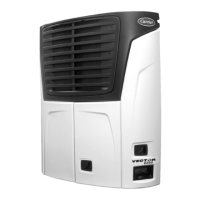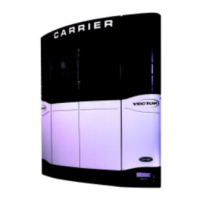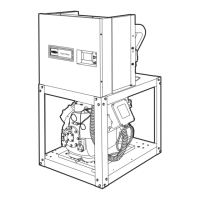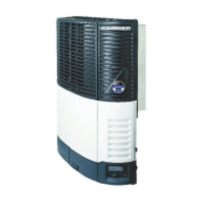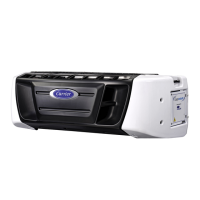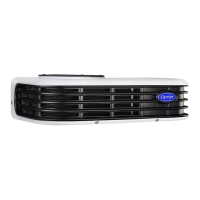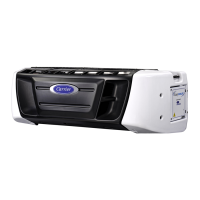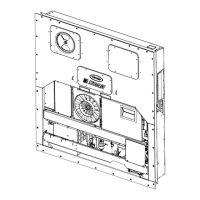62-61753-21
reverse flush (opposite normal air flow) with clean
water at mild pressure.
A garden hose with spray nozzle is usually suffi-
cient. Ensure drain lines are clean.
c. Run unit until defrost mode can be initiated to check
for proper draining from drain pan.
Coil Replacement
a. Remove the refrigerant charge. (Refer to section
8.5.1).
b. Ensure the unit is disconnected from the power
source and that SROS is in OFF position.
c. Disconnect return air sensor (RAT) and remove
screen. Remove upper louvered panel.
d. Remove heater connection service access cover
(see to Figure 2-3) and disconnect heaters.
e. Disconnect and remove the defrost termination tem-
perature sensor (DTT), evaporator outlet pressure
transducer (EVOP) and evaporator outlet tempera-
ture sensor (EVOT). Disconnect air switch tubing.
f. Disconnect and remove the evaporator expansion
valve coil. Remove suction line between coil stub
and suction modulating valve and liquid line with
EVXV body.
g. Remove the mounting hardware from the coil.
h. After defective coil is removed from unit, note loca-
tion of heaters (dimension form right end), remove
heaters and install on replacement coil.
i. Install coil assembly by reversing above steps.
j. Leak check, evacuate the unit and charge in ac-
cordance with sections 8.5.2, 8.5.3 & 8.5.4.
8.6.3 Condenser Coil
Coil Cleaning
Remove all foreign material from the conden-
ser/radiator coil by reversing the normal air flow. (Air is
pulled in through the front and discharges over the
engine.) Compressed air or water may be used as a
cleaning agent. It may be necessary to use warm wa-
ter mixed with any good commercial dishwasher de-
tergent. Rinse coil with fresh water if a detergent is
used.
Coil Replacement
a. Remove the refrigerant charge. (Refer to section
8.5.1).
b. Drain engine coolant, refer to section 8.4.10 and
remove coolant hoses.
c. Remove the condenser grille.
d. Unsolder discharge line, subcooler lines and liquid
outlet line.
e. Remove coil mounting hardware and remove the
coil.
f. Install replacement coil and solder connections.
g. Leak check, evacuate the unit and charge in ac-
cordance with sections 8.5.2, 8.5.3 & 8.5.4.
h. Reconnect coolant hoses and refill engine coolant
(Refer to section 8.5.1).
8.6.4 Economizer Heat Exchanger
a. Remove the refrigerant charge. (Refer to section
8.5.1).
b. Ensure the unit is disconnected from the power
source and that SROS is in the OFF position.
c. Remove insulation and clamps from economizer line
assemblies (refer to figure Figure 8-12).
d. Remove liquid Injection Solenoid Valve, Economizer
Solenoid Valve and Unloader Solenoid Valve coils.
e. Remove thermal expansion valve bulb.
f. Unbraze the liquid injection line at either valve con-
nection. Disconnect the economizer line at the un-
loader solenoid valve and compressor economizer
connection, unbraze line from economizer heat ex-
changer.
g. Disconnect the liquid inlet line at the filter drier and
unbraze line from economizer.
h. Disconnect the liquid outlet line at the connection
just above the economizer heat exchanger and un-
braze line from economizer heat exchanger.
i. Remove economizer heat exchanger, bolt replace-
ment economizer heat exchanger in place and
rebraze lines by reversing the previous steps.
j. Procure new O-rings. Lubricate the O-rings, back
side of sleeves and coupling nuts. Using a backup
wrench at each connection torque as follows
41 to 51 Nm
(30 to 38 ft-lbs.)
81 to 89 Nm
(60 to 66 ft-lbs.)
52 to 57 Nm
(38 to 42 ft-lbs.)
32 to 36 Nm
(24 to 27 ft-lbs.)
k. Leak check, evacuate the unit and charge in ac-
cordance with sections 8.5.2, 8.5.3 & 8.5.4.
l. reinstall the thermal expansion valve bulb, valve
coils and insulation.
m. Place unit back in service and check operation.
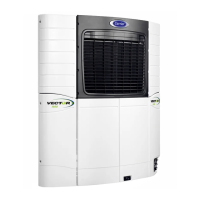
